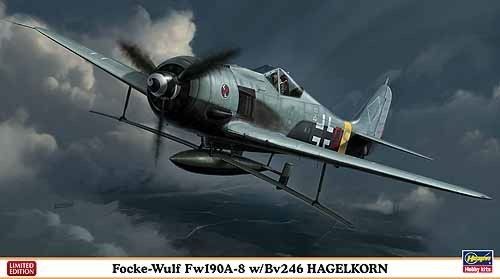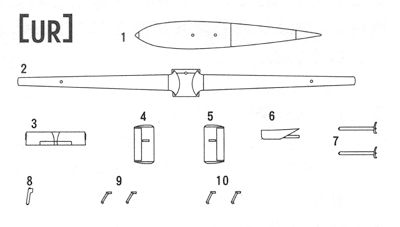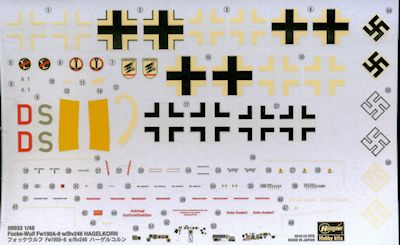
Hasegawa 1/48 FW-190A-8 w Bv-246 'Hagelkorn'
| KIT #: | 09933 |
| PRICE: | $29.99 on sale ($73.00 SRP) |
| DECALS: | Two options |
| REVIEWER: | Scott Van Aken |
| NOTES: | late 2010 release |

| HISTORY |
The FW-190A-8 was the penultimate radial engine 190 version, (the last production A model was the up-engined A-9). It was probably the most widely used version of the last months of the war, though by then there was little it or any other weapons system could really due to stem the tide of Allied advances.
The A-8 version was basically an updated A-7. The A-7 variant brought into production the replacement of the 7.92mm cowl machine guns with 13.3 mm versions, a distinguishing feature of the version. However, fewer than 100 were built before moving on to the most produced variant, the A-8 with about 1,300 completed before war's end. There were a myriad of 'options' that could be attached to the A-8 air frame in terms of weapons and armor. Suffice it to say, it was a very nice handling aircraft and thanks to its roomier cockpit and wider tracked landing gear, often preferred over the later model 109s.
The Blohm & Voss BV 246 Hagelkorn (German language: "Hailstone") was a guided glide bomb developed to bomb specific targets (bridges, ships, etc.) once it was released.
This glider was designed by Dr. Richard Vogt, at first under the designation of BV 226, which was later changed to its definitive designation BV 246 on December 12, 1943.
It was intended to be dropped from a Ju 88 or a Heinkel He 111 bomber, either of which could carry three of the weapons, and was to be dropped from a height of 7,000 m (23,000 ft) at a speed of 550 km/h (340 mph), giving it a range of up to 210 km (130 mi). In a slight dive the Bv 226 could reach a speed of 900 km/h (560 mph).
The construction of the BV 246 was very simple, so it could be mass-produced. It had clean aerodynamics, with high aspect ratio wings that made possible a glide ratio of 25:1. The wings were made of concrete, cast around a steel core. It had a cruciform tail in an early version and a double vertical tail mounted on the sides of a wide horizontal stabilizer in a later version. It had a length of 3.53 m (11.6 ft) and a wingspan of 6.4 m (21 ft). Its total weight was 730 kg (1,610 lb), of which 435 kg (959 lb) was the explosive warhead.
Initial tests revealed that the basic design was workable, but that the weapon was very inaccurate and because of this it was rejected. However, work was restarted in 1943, with 11 different versions being planned, due to its simple and inexpensive construction, and the new development contract was awarded to the Karlshagen test centre. A series of tests was begun to improve the weapon's accuracy, with air drops performed by KG 101. Despite unpromising results, the Ministry of Aviation nevertheless issued the order to commence mass production on 12 December 1943. In February 1944 the contract was cancelled due to the success of the V-1 flying bomb.
The weapon was revived a further time, in early 1945, as an early form of anti-radiation missile, using the Radieschen passive seeker which was designed to home in on Allied radar transmitters; around 1,000 units were produced but never used operationally.
| THE KIT |
 This
is a continuation of the various FW-190A kits that have been produced by
Hasegawa. Interestingly they have followed a logical progression of versions for
their kit releases, the last one being the A-5 version with the BMW car from
last year. This one brings us up to the FW-190A-8 version as flown by many of
the Luftwaffe's ace pilots.
This
is a continuation of the various FW-190A kits that have been produced by
Hasegawa. Interestingly they have followed a logical progression of versions for
their kit releases, the last one being the A-5 version with the BMW car from
last year. This one brings us up to the FW-190A-8 version as flown by many of
the Luftwaffe's ace pilots.
There is little that is much different from the A-5 version aside from those bits needed to make the A-8. This includes a new upper cowling with the bulges to accommodate the larger guns, lower wing antenna and a few other pieces. A new 'blown' canopy is in with the kit, but not used on either markings variant. Likewise there is another set of lower gun access panels with extended shell chutes that is not used. Same goes for a bomb and wing racks.
Some very minor surgery and hole opening will be needed
on this one and in line with others in
this series, the five piece
cowling will need care in assembly. Two drop tank rack options are given, one
 being a larger version of the other. One of the bug-a-boos of 190 kits is the
prop and while I can't say for sure, this one does very much look the part.
being a larger version of the other. One of the bug-a-boos of 190 kits is the
prop and while I can't say for sure, this one does very much look the part.
What made this an expensive kit is the inclusion of a resin Bv-246. This is molded in pretty nearly the same shade as the kit plastic. In addition to the weapon, you get resin attachment bits for the bomb rack and under the wings. One drills a hole in the shell ejector insert for the wing braces.
 Instructions
are the usual well done versions with Gunze references. I also noticed several
small drawings to help with alignment and getting parts installed properly where
they might be reversed. A nice touch. Markings are for two aircraft. The box art
plane is a whiffer from KG 53 in what the folks at Hasegawa figure would be the
appropriate scheme. The other option is for a rather unremarkable 190 in
standard paint that was used to test the weapon. Decals are well printed and
provide instrument and side console decals in case you don't want to paint the
nicely done raised detailing provided on the kit parts. My experience shows that
with care, the decals will fit right over the panel details. These decals are
'old school' decals with the whites that are off white so you may want to
replace the insignia with aftermarket.
Instructions
are the usual well done versions with Gunze references. I also noticed several
small drawings to help with alignment and getting parts installed properly where
they might be reversed. A nice touch. Markings are for two aircraft. The box art
plane is a whiffer from KG 53 in what the folks at Hasegawa figure would be the
appropriate scheme. The other option is for a rather unremarkable 190 in
standard paint that was used to test the weapon. Decals are well printed and
provide instrument and side console decals in case you don't want to paint the
nicely done raised detailing provided on the kit parts. My experience shows that
with care, the decals will fit right over the panel details. These decals are
'old school' decals with the whites that are off white so you may want to
replace the insignia with aftermarket.
| CONCLUSIONS |
This one is a borderline Luft '46 kit, especially if you choose the operational version over the test aircraft. Still, it will make into a nice kit and be something a bit different in your FW-190 collection.
December 2013
You can thank me for finding this one on sale.
If you would like your product reviewed fairly and quickly, please contact me or see other details in the Note to Contributors.